IRAQ SRI ARCHIVES
|
||
|
||
SRI Activities Archives (2005-2014)
2013-2014
 Nine Years of SRI Progress in Iraq Presented at UNESCO Drought Risk Management Workshop in Jordan
Nine Years of SRI Progress in Iraq Presented at UNESCO Drought Risk Management Workshop in Jordan
[March 2014] At the invitation of the UNESCO-Iraq Office at Amman, Khidhir Abbas Hameed from the Agricultural Research Office Al-Mishkhab Rice Research station in Iraq made a presentation on Iraq's Strategy for Innovative Rice Irrigation and Water Management in Iraq at the-drought Risk Management, Desertification and Dust Storms Workshop (right) held March 2-6, 2014, in Amman, Jordan. The event, which was one of three workshops to create a database of indicators to formulate policies and strategies on Iraq's increasing water
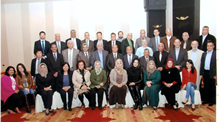 scarcity, was sponsored by the United Nations Education, Scientific and Cultural Organization (UNESCO) with the support of UNDP, UNEP, and FAO. This final validation workshop was held to discuss key outputs with government delegations from line ministries, and endorse the recommended actions to appropriately meet drought risk related challenges in Iraq.
scarcity, was sponsored by the United Nations Education, Scientific and Cultural Organization (UNESCO) with the support of UNDP, UNEP, and FAO. This final validation workshop was held to discuss key outputs with government delegations from line ministries, and endorse the recommended actions to appropriately meet drought risk related challenges in Iraq. In his presentation, Hameed relayed that SRI began in Iraq in 2005 with two of the SRI practices (wide spacing and young seedlings) on ¼ ha and just one farmer, and resulted in a yield increase of 18%. Additional successful trials and demonstrations at Al-Mishkhab Rice Research Station in Najaf and on farmers' fields led to large scale implementation in three provinces from 2009-2013. He listed the benefits obtained with SRI practice as 1) improvement in soil fertility, 2) reduction in the requirements for irrigation water, and 3) increased net income for farmers. The highest average harvested yield reached 7.2 tons/ha, and lowest was 6.4 tons/ha (for those not yet using full set of SRI practices.) Hameed's recommendations for future work on SRI in Iraq included: Studies on nutrient management with special reference to benefits and costs of using organic sources of nutrients; precise quantification of savings in water; studies on microbial activity and detailed work on root system; identification of locations most suitable for SRI (including socio-economic analysis of SRI effects); application of eco-friendly methods to save the environment; and the improvement of local rice varieties adaptable to drought and salinity, tolerance of water stress, and high yield (while still retaining good quality); development of a strategy to use sustainable saline water for irrigation and reclamation; and implementation of SRI methods into large-scale areas. (For details, see the powerpoint presentation.)
 Attitude of Rice Farmers Towards SRI at Evaluated at Al-Muthanna
Attitude of Rice Farmers Towards SRI at Evaluated at Al-Muthanna
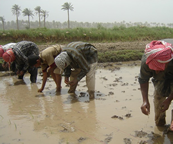 Research was carried out by Al-Mishkhab
Rice Research Station (MRRS) in Al-Muthanna Governorate to identify farmers attitudes towards SRI and to elucidate the relationships between farmers' attitudes and several personal and social factors.
The population studied consisted of all the rice farmers in Al-Muthanna Governorate who had been covered by activities, training, and application of SRI -- approximately 2,400 farmers in Rumatha, Warkaa, Majd, and Najmi locations.
A random proportionate sample (5%) was selected, bringing the sample size to 120 farmers who answered the questionnaire.
The results showed that 65% of respondents had a favorable attitude towards using all the SRI practices, 22% of respondents had not formed an opinion, and 13% of respondents had an unfavorable attitude. Attitudes toward the individual practices were all higher on average than using all the practices together, with individual practices consisting of transplanting of single seedlings, wide spacing of transplanting, early transplanting, organic fertilizer production and use, green manure, application of intermittent irrigation, hand and mechanical weeding. Results showed significant differences in respondents' attitudes according to certain variables: Education level, size of holding, type of holding, and number of years of rice-growing experience. No significant differences in respondents' attitudes were found according to these variables: age, size of family, participation in agricultural extension activities, and agricultural information sources. See full report for details.
Research was carried out by Al-Mishkhab
Rice Research Station (MRRS) in Al-Muthanna Governorate to identify farmers attitudes towards SRI and to elucidate the relationships between farmers' attitudes and several personal and social factors.
The population studied consisted of all the rice farmers in Al-Muthanna Governorate who had been covered by activities, training, and application of SRI -- approximately 2,400 farmers in Rumatha, Warkaa, Majd, and Najmi locations.
A random proportionate sample (5%) was selected, bringing the sample size to 120 farmers who answered the questionnaire.
The results showed that 65% of respondents had a favorable attitude towards using all the SRI practices, 22% of respondents had not formed an opinion, and 13% of respondents had an unfavorable attitude. Attitudes toward the individual practices were all higher on average than using all the practices together, with individual practices consisting of transplanting of single seedlings, wide spacing of transplanting, early transplanting, organic fertilizer production and use, green manure, application of intermittent irrigation, hand and mechanical weeding. Results showed significant differences in respondents' attitudes according to certain variables: Education level, size of holding, type of holding, and number of years of rice-growing experience. No significant differences in respondents' attitudes were found according to these variables: age, size of family, participation in agricultural extension activities, and agricultural information sources. See full report for details.Recommendations based on the findings of the study are to a) scale up by using transplanting machines (and make them available) and introduce simple rotary weeders to reduce herbicides, thereby reducing soil and water pollution as well, b) establish a special symposium, extension program, and training course about SRI in order to change unfavorable attitudes and solidify undecided attitudes, taking farmers' suggestions into account, and emphasizing organic manure production, intermittent irrigation, and other useful innovations, and c) plant a clover crop instead of wheat between rice crops to enhance the soil’s fertility in rice-growing areas.
2011 ACTIVITIES
 May 2011 Workshop Highlights SRI Progress during Past Five
Years
May 2011 Workshop Highlights SRI Progress during Past Five
Years
Khidhir Hameed, Al-Mishkhab Rice Research station, presented an update of SRI progress at a workshop at the Ministry of Agriculture held on May 10, 2011. Attendees included, among others, Senior Undersecretary Dr. Mahdi Dhamad, a ministerial consultant, Dr. Faisal Nasser, the director of planning, many agricultural specialists from Najaf, Diwaniya, Muthanna, Kut and Thi Qar provinces, and other government representatives. In addition to discussions on past and future SRI research and extension, Hameed's presentation included a proposal for SRI support by the European Union and an SRI documentary. He was congratulated on his work with SRI over the past five years to solve water scarcity, stem soil fertility decline, and conserve the environment in rice-growing areas.
There was interest among participants in applying SRI methods in a number of other provinces, with most supporting the use of transplanting machines in their areas due to labor considerations. Following the meeting, the Minister of Agriculture agreed to establish an SRI ministerial committee for planning and managing the SRI system in Iraq.
 Journal article in Paddy and Water Environment Documents SRI Success in
Iraq
Journal article in Paddy and Water Environment Documents SRI Success in
Iraq
The Journal of Paddy and Water Environment published an article on February 22, 2011, by Khidir Hameed and his colleagues at
 Al-Mishkhab
Rice Research Station (MRRS) about irrigation water, which is a limiting factor
for rice cultivation and expansion in Iraq. The article, Irrigation water reduction
using System of Rice Intensification compared with conventional cultivation
methods in Iraq, covers a field study conducted at MRRS during the
summer season 2009 to evaluate irrigation water use efficiency (IWUE) using
Anbar 33 variety with SRI methods compared to traditional practices. The
results indicated more vigorous growth of roots (see photo at right) under SRI
methods (reaching 13,004 cm plant-1 compared with non-SRI results of 4,722 cm
plant-1) and a 42% increase in grain yield. Water use efficiency (WUE) (0.291
kg m-2 compared with WUE of 0.108 kg m-2 for non-SRI cultivation) was almost a
threefold difference thereby reducing the need for irrigation water by
38.5%.
Al-Mishkhab
Rice Research Station (MRRS) about irrigation water, which is a limiting factor
for rice cultivation and expansion in Iraq. The article, Irrigation water reduction
using System of Rice Intensification compared with conventional cultivation
methods in Iraq, covers a field study conducted at MRRS during the
summer season 2009 to evaluate irrigation water use efficiency (IWUE) using
Anbar 33 variety with SRI methods compared to traditional practices. The
results indicated more vigorous growth of roots (see photo at right) under SRI
methods (reaching 13,004 cm plant-1 compared with non-SRI results of 4,722 cm
plant-1) and a 42% increase in grain yield. Water use efficiency (WUE) (0.291
kg m-2 compared with WUE of 0.108 kg m-2 for non-SRI cultivation) was almost a
threefold difference thereby reducing the need for irrigation water by
38.5%.Implementation of intermittent irrigation will save farmers substantial expenditure for water pumping by reducing the hours of operation when using SRI practices. This study showed that with SRI, the days of applying water could be 25% less, 95 rather than 126 days, with 40% higher yield. The authors believe that if SRI methods are used with rice varieties having short growth duration, the saving could reach 50%. Reducing water requirements for rice could be a major contribution to agriculture in Iraq to help counter the severe shortages in water that are facing Iraq now and in the years to come.
2010 ACTIVITIES
-
SRI Initiator Honored in Iraq
Dr. Khidhir Abbas Hameed, rice scientist at the Al-Mishkhab Rice Research Station in Najaf -- who began assessment of SRI methods under Iraqi conditions in 2005 and has been promoting SRI evaluation and demonstrations in Iraq since then -- was given an award by the Prime Minister during the country's Second Agricultural Week held at the Baghdad International Fairgrounds, April 14-21, 2010. This award was in recognition of his work on SRI and water management. Dr. Khidhir was nominated by the Director of the State Board for Agricultural Research, which has become increasingly supportive of SRI initiatives.
The Ministry of Agriculture’s working paper, “To make Iraq a green oasis," has listed "Dissemination of System of Rice Intensification" as one of the innovations to be promoted, along with import of transplanting machines for rice from Vietnam.
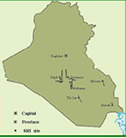 Dr. Khidhir has
been experimenting with accommodations between SRI methods and mechanical
transplanting so that these can beused together, and also the use of clover as
a green manure crop with SRI to improve soil fertility.
Dr. Khidhir has
been experimenting with accommodations between SRI methods and mechanical
transplanting so that these can beused together, and also the use of clover as
a green manure crop with SRI to improve soil fertility. -
Najaf and Diwaniya Provinces Report 2009 Season Activities
Supported by the Iraq Ministry of Agriculture, the State Bureau of Agricultural Research (SBAR) and Al-Mishkhab Rice Research Station (MRRS) are continuing their SRI work in Najaf and Diwaniya Provinces in 2010, with cooperation from the State Board of Agriculture Extension and Cooperation (SBAEC) and the Directorates of Agriculture (DAs) in those provinces (see enlargeable map at right for SRI sites in Iraq as of 2010). During 2009, activities included SRI demonstrations and evaluation in farmers’ fields, training courses, water use efficiency (WUE) studies, trials with mechanical planting, and clover crop cultivation to restore soil fertility. Following is a summary of the season 2009 final report:
- Trainings and
Lectures: To acquaint rice farmers and agriculture staff with SRI,
the State Board of Agriculture Extension
 and Cooperation
(SBAEC) in collaboration with the State Board for Agricultural Research
(SBAR) organized a series of SRI lectures
that were held between April 29 and June 24, 2009. Khidhir Hameed from
Al-Mishkhab Rice Research Station delivered the lectures, which were followed
by application of SRI on demonstration fields. Ten SRI lectures were held for
staff in the Agriculture Directorates and Department in Najaf and Diwaniya
Provinces with an additional two lectures for his colleagues. For reducing
labor in transplanting, two short training courses were held for farmers and
staff on using a transplanting machine in those provinces (click on picture
at left to enlarge).
and Cooperation
(SBAEC) in collaboration with the State Board for Agricultural Research
(SBAR) organized a series of SRI lectures
that were held between April 29 and June 24, 2009. Khidhir Hameed from
Al-Mishkhab Rice Research Station delivered the lectures, which were followed
by application of SRI on demonstration fields. Ten SRI lectures were held for
staff in the Agriculture Directorates and Department in Najaf and Diwaniya
Provinces with an additional two lectures for his colleagues. For reducing
labor in transplanting, two short training courses were held for farmers and
staff on using a transplanting machine in those provinces (click on picture
at left to enlarge).
-
SRI Practice / Field Evaluation: Eight locations in Najaf
and Diwaniya Provinces were chosen for SRI evaluation and demonstration,
with one farmer from each district and sub-district. Treatments included
SRI with various combinations of OM and chemical fertilizers (with one to
two 17-day-old seedlings per hill; 20×20 cm between seedlings;
alternate wetting and drying during vegetative phase) as well as the
conventional practice (chemical fertilizer, four to five 30-40 day old
seedlings per hill, 10×15 cm between hills; continuous irrigation).
The SRI treatment using 5 tons/ha of OM combined with half the usual amount
of chemical fertilizer gave the highest average grain yield (7,360 ton/ha),
22% more than the lowest treatment (6,036 ton/ha), which was farmers’
current transplanting methods.
Despite using a lot of seed, chemical fertilizer and water (due to continuous flooding), conventional direct-sowing methods produced only 1.2% more than conventional transplanting, and they yielded 17% and 10% less than SRI methods where half of the recommended chemical fertilizer was replaced by 5 or 10 ton/ha organic matter. (See report for details.)
-
Mechanical Transplanting (MTP) : SBAEC has undertaken a
paddy mechanization project in cooperation with SBAR and MRRS at seven
sites in three provinces (Najaf, Diwaniya, and Muthanna provinces). Trials
on 10.5 ha. were undertaken with 17- to 20-day-old Jasmine rice seedlings
with 30×15 cm between seedlings. Seedlings were raised in the same
way as with SRI, and the methods have been influenced by the SRI work of
MRRS. Expansion of this method is slow due to the need for more capital
investment, and also it has not been determined who will be importing the
machines. The average yield with MTP was 6,756 ton/ha -- 16% more than the
5,966 tons/ha average for traditional methods of crop establishment
(although some part of the increase could be due to the use of younger
seedlings and the wider spacing).
Flayeh Abed Jaber and Khidir Hameed have produced a video on paddy mechanization for Al-Mishkab Rice Research Station (MRRS) in Najaf, Iraq. This three-minute video, now available on YouTube, describes land preparation, seed selection, nursery development, and planting with the use of a mechanized transplanter adapted by MRRS. (See also PowerPoint photos.)
-
SRI Water-Use Efficiency Study: A field study conducted at MRRS during 2009 on 10×10 m plots to evaluate irrigation water-use efficiency (IWUE) compared SRI cultivation with traditional methods. The results indicated more vigorous growth of roots under SRI methods, reaching 13,004 cm/plant compared with non-SRI results of 4,722 cm/plant. According the report, there was a 42% increase in grain yield when SRI methods were used. Under SRI methods, the WUE reached 0.291 kg/m2 compared with non-SRI WUE of 0.108 kg/m2, almost a three-fold difference. SRI reduced the need for irrigation water by about
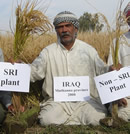 38.5%.
38.5%. -
Honoring Excellent Farmers: Abdul Amir Owais from Muthanna Province, shown at right, went beyond the experimentation and evaluation stage with SRI, and was awarded by the Minister of Agriculture for his efforts with a transplanting machine and paddy harrow.
-
Clover Crop Cultivation for Soil Improvement: More than 100 farmers have now cultivated a clover crop after rice to restore fertility of their rice-growing lands in three provinces (Najaf, Diwaniya, and Muthanna Provinces), although this still done in small areas since the government has not received clover seeds, and farmers therefore are refraining from planting this soil-restoring crop in large areas.
- Trainings and
Lectures: To acquaint rice farmers and agriculture staff with SRI,
the State Board of Agriculture Extension
-
SRI at Agriculture Fair in
Najaf Province, Iraq
The Agriculture Engineers Association (AEA) in
 Najaf province
organized its 6th Agriculture Fair, held November 19-21, 2009. AEA invited
staff of Al-Mishkab Rice ResearchStation (MRRS) to present new technologies
from their rice research at the event. Many farmers and College of Agriculture
students visited the fair, which was opened by the Governor and other
officials. The MRRS SRI display at the fair is shown at right. (See also
report with additional photos).
Najaf province
organized its 6th Agriculture Fair, held November 19-21, 2009. AEA invited
staff of Al-Mishkab Rice ResearchStation (MRRS) to present new technologies
from their rice research at the event. Many farmers and College of Agriculture
students visited the fair, which was opened by the Governor and other
officials. The MRRS SRI display at the fair is shown at right. (See also
report with additional photos).Flayeh Abed Jaber, MRRS director, who showed pictures of five years of SRI activities at the Fair, also explained MRRS activities with SRI methodology to the Governor. A rice conference was suggested to discuss with farmers and others the best ways to promote the rice sector in the province. Khidhir Hameed, who was interviewed by the Al-Hurra Satellite television channel, reported on SRI's contributions to reducing water use for rice irrigation by 40%. Water-saving is especially important in Iraq whose farmers are increasingly suffering from water scarcity.
2009 ACTIVITIES
-
Report on 2008 SRI Trials with Jasmine Rice Completed in Al-Muthanna
Province
Field experiments were conducted during summer season 2008 in Al-Muthanna Province in southern Iraq at four sites (Al-Rumatha District and Al-Warkaa, Al-Najmi and Al-Majd Sub-Districts) to study the influence of System of Rice Intensification (SRI) practices on grain yield and yield components of Jasmine rice. The results of this evaluation confirmed that SRI practices can significantly increase grain yields under Iraqi conditions (7,040 kg/ha, compared with non-SRI cultivation methods that gave 4,668 kg/ha on average.)
As important as the 50% increase in yield was the accompanying reduced water requirements and lower costs of production. This offers even greater benefits for farmers and the country. Trials showed seed savings of 80%, and despite greatly reduced plant populations, improvements in both plant performance and yield ensued. For implementation of SRI over large farm areas, the authors (Hameed et al.) recommend use of a transplanting machine, which is being tested at the Al-Mishkhab Rice Research Station, Najaf, Iraq (see video).
-
Economic Evaluation of SRI Practices in Iraq Released
 Dr. Abdul Hussein
El-Hakim had done an assessment of the
economic costs and returns for 16 farmers in four districts of Al-Muthanna
province who used both SRI and conventional methods on their farms in 2008 to
make a systematic comparison and evaluation, as well as for 16 nearby farmers
who grew rice with their usual methods. The farmer evaluations of SRI were
uniformly positive, citing 25-30% less irrigation water required, a 50%
reduction in fertilizer and 75-80% reduction in seed requirements; this was
achieved with a 100% reduction in agrochemical crop protection. Average yields
were 75% higher with SRI methods. These benefits are starting to attract
support from the Ministry of Agriculture and donor agencies, according to Dr.
Khidhir Hameed, Al-Mishkhab Rice Research Station in Najaf.
Dr. Abdul Hussein
El-Hakim had done an assessment of the
economic costs and returns for 16 farmers in four districts of Al-Muthanna
province who used both SRI and conventional methods on their farms in 2008 to
make a systematic comparison and evaluation, as well as for 16 nearby farmers
who grew rice with their usual methods. The farmer evaluations of SRI were
uniformly positive, citing 25-30% less irrigation water required, a 50%
reduction in fertilizer and 75-80% reduction in seed requirements; this was
achieved with a 100% reduction in agrochemical crop protection. Average yields
were 75% higher with SRI methods. These benefits are starting to attract
support from the Ministry of Agriculture and donor agencies, according to Dr.
Khidhir Hameed, Al-Mishkhab Rice Research Station in Najaf.
2008 ACTIVITIES
-
Report on Iraq Activities and Results for 2008
Dr. Khidhir Hameed at the Al-Mishkhab Rice Research Station near Najaf has sent in a report
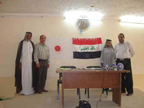 on SRI training and
results for 2008. A report on an SRI field day conducted in October has already
been posted (see item below). The expansion of SRI work
in Iraq was made possible by a Japanese donor who learned about the initiatives
of Dr. Khidhir and colleagues through this SRI website
(see raising of Japanese and Iraqi flags at the project site at left).
on SRI training and
results for 2008. A report on an SRI field day conducted in October has already
been posted (see item below). The expansion of SRI work
in Iraq was made possible by a Japanese donor who learned about the initiatives
of Dr. Khidhir and colleagues through this SRI website
(see raising of Japanese and Iraqi flags at the project site at left).During April and May, 2008, training on SRI methods was provided to 1,600 men and 400 women farmers in Al-Muthanna province. This was supplemented by 12 field demonstrations that were visited by over 1,200 farmers during the season. Training was also given to farmers on producing organic manure from farm materials.
Detailed data for 16 farmers in four districts of the province who did controlled comparison trials showed yield increases ranging from 17 to 130%, with an average increase of 72%. There were also experiments with mechanical transplanting at 5 sites, with 13-27% yield increases.
A third area for experimentation was use of clover cover crop as a green manure. Two of the 40 farmers who cooperated on this initiative had yield increases over 30%, 11 had 10-29% more yield attributable to the use of green manure; 25 had 10-19% increase, and 2 had less than 10% more. The SRI work in Iraq started in 2005 with one farmer and 0.25 ha. In 2008, there were 60 farmers cooperating with the Rice Research Station in demonstrations on 16 hectares, and more have begun utilizing the methods that they have been trained in or have seen demonstrated.
-
Field Day at Al-Mishkhab Rice
Research Station
On October 23, 2008, a rice field day at Al-Mishkhab Rice Research Station (MRRS) was attended by more than 400 rice farmers, specialists
 from Baghdad, Kufa,
Qadisiya, and Babylon Universities, personnel from the State Board of
Agricultural Research (SBAR), the State Board of Agriculture Extension and
Cooperation, and the Directorates of Agriculture in Muthanna, Diwaniya and
Najaf Provinces, and by many of the political and governmental chiefs from
Najaf and Diwaniya provinces (see event
photos). The SRI poster at left was distributed to participants (click on
photo to enlarge).
from Baghdad, Kufa,
Qadisiya, and Babylon Universities, personnel from the State Board of
Agricultural Research (SBAR), the State Board of Agriculture Extension and
Cooperation, and the Directorates of Agriculture in Muthanna, Diwaniya and
Najaf Provinces, and by many of the political and governmental chiefs from
Najaf and Diwaniya provinces (see event
photos). The SRI poster at left was distributed to participants (click on
photo to enlarge). -
Sixteen
Lectures/Demonstrations held In Al-Muthanna Province
Dr. Khidhir Hameed reports that there were 16 lectures on SRI held in Al-Muthanna Province, April 20-May 6, 2008, followed by establishment of SRI practices and applications in 16 demonstration fields (see report with photos). The National SRI Committee based at the Al-Mishkhab Rice Research Station (MRRS) in Najaf has received support from the Iraqi Ministry of Agriculture for application of SRI in Najaf Province beginning next year (2009) for the two years. Because of water shortage this season, given reduction in rainfall, there is heightened interest in SRI possibilities. The State Board of Agricultural Extension and Cooperation and MRRS are setting up demonstrations of mechanical transplanting, following SRI principles, in four rice-growing provinces. (See 2008 photo album of SRI in Iraq).
2007 ACTIVITIES
-
Review of 2007 SRI Results
Dr. Khidhir Hameed and colleagues at the Al-Mishkhab Rice Research Station near Najaf have sent a summary of their SRI work this past year, which involved evaluations of SRI practices such as age of seedling, spacing, fertilization, and varietal responses. One interesting result was that in the soil where the trials were done, Jasmine rice gave its highest yield with no fertilization, chemical or organic, 6.1 t/ha. With variety Furat 1, highest yield was with 70 kg N, 6.88 t/ha. Other trials showed organic fertilization outperforming chemical fertilization, but with highest yield coming with some combination of both.
The report from Iraq has a picture of a simple device (below-left and right)
 made for
guiding inter-plant spacing when
made for
guiding inter-plant spacing when  transplanting
which Iraqi colleagues have found helpful. Their demonstration and extension
activities were conducted in 25 locations within Iraq during 2007. In February
2008, training in SRI methods was planned for 2000 farmers in Muthanna
Province. The report includes the results from experiments with mechanical
transplanting, which gives good yield with reduced labor, though the highest
yield has been achieved with SRI methods. Of interest outside Iraq may be the
results that Khidhir and colleagues have gotten using clover as a green
manure/cover crop rotating with SRI. This improved soil characteristics and
raised rice yields by an average of 24% on soils that are not otherwise very
fertile.
transplanting
which Iraqi colleagues have found helpful. Their demonstration and extension
activities were conducted in 25 locations within Iraq during 2007. In February
2008, training in SRI methods was planned for 2000 farmers in Muthanna
Province. The report includes the results from experiments with mechanical
transplanting, which gives good yield with reduced labor, though the highest
yield has been achieved with SRI methods. Of interest outside Iraq may be the
results that Khidhir and colleagues have gotten using clover as a green
manure/cover crop rotating with SRI. This improved soil characteristics and
raised rice yields by an average of 24% on soils that are not otherwise very
fertile. -
Visitors shown SRI Demonstrations at Mishkab Rice Research
Station
Dr. Khidir has sent in a report (with excellent photos) on various agricultural officials at different levels in the Iraqi government who have been visiting the Al-Mishkab station this past few months to see the results of SRI trials and demonstrations.
-
SRI
Training Course Held in Diwaniya province
The State Board of Agricultural Extension and Cooperation and MRRS held a five day training course, 9-13 September 2007, at the Agriculture Extension and Training Center in Diwaniya province. Flayeh Abed Jaber, MRRS director, and Khidir made presentations to 28 agricultural staff from 8 provinces (Baghdad, Messan, Babel, Diwaniya, Muthanna, Thi Qar, Basrah, and Najaf). The training included the theoretical and practical parts on using new mechanical transplanting, its benefits and economic analysis (see report).
-
SRI in the Iraqi Media
Dr. Khidir Hameed reports that they have been able to get SRI concepts published in the Iraqi media, with feature articles in Tareek Al-Shaab (People's Way) and Al-Sabaah (The Morning), important newspapers, and an article in the magazine, Iraq Agriculture, published by the Ministry of Agriculture (see media report). Dr. Hameed has also sent several TV program clips about his SRI work and related rice projects in Iraq. The downloadable material, which is in Arabic, was originally broadcast on Al Ghadeer TV (23.8 MB) in the province of Najaf (24.8 MB), Al Diyar TV in Baghdad (2.84 MB) and Salah Al-Deen, which is also in Baghdad (18.0 MB).
-
Formal SRI Committee Established in Iraq
Dr. Hameed reports that an SRI committee has been established with several staff of the Al-Mishkab Rice Research Station (MRRS) near Najaf, including its Director, and a representative from the General Company for Horticulture and Forestry, which has experience with the production and management of organic matter. The committee intends to promote extension of SRI methods in Iraq and to formulate a national SRI project.
2006 ACTIVITIES
-
Adaptations of SRI Being Used in Iraq
Dr. Khidir A. Hameed (left) has reported on adaptations of SRI being
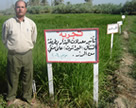 evaluated at
the Al-Mishkhab Rice Research Station near Najaf in southern Iraq during 2006
(see report). Because labor scarcity has made
transplanting difficult in this country, a 'parachute planting' method has been
introduced, throwing young seedlings onto a shallow-puddled field, where they
establish themselves without being pushed into the soil. The trials carried out
in three provinces (Basrah, Messan and Thi-Qar) were impressive enough that the
Minister of Agriculture, when visiting them, promised to support extension of
the new methods. The average increase across all trials was only slightly
positive, but this included trials where yields were reduced due to improper
nursery management, including no water control, and high water salinity.
evaluated at
the Al-Mishkhab Rice Research Station near Najaf in southern Iraq during 2006
(see report). Because labor scarcity has made
transplanting difficult in this country, a 'parachute planting' method has been
introduced, throwing young seedlings onto a shallow-puddled field, where they
establish themselves without being pushed into the soil. The trials carried out
in three provinces (Basrah, Messan and Thi-Qar) were impressive enough that the
Minister of Agriculture, when visiting them, promised to support extension of
the new methods. The average increase across all trials was only slightly
positive, but this included trials where yields were reduced due to improper
nursery management, including no water control, and high water salinity.Where the SRI elements were conjoined effectively,
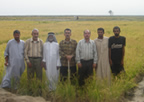 yield increases
of 20-26% were achieved with reduction in water requirements (important in this
area). SRI has gotten researchers to pay more attention to use of organic
matter instead of relying entirely on chemical fertilizer, with promising
results. They have found that they can get cost-effective results with just 10
t/ha of composted manure rather than 15 t/ha as was expected to be necessary.
The research staff (click on
picture at right to enlarge) plan to establish committees in all
rice-growing provinces of Iraq for further trials and demonstrations in
2007.
yield increases
of 20-26% were achieved with reduction in water requirements (important in this
area). SRI has gotten researchers to pay more attention to use of organic
matter instead of relying entirely on chemical fertilizer, with promising
results. They have found that they can get cost-effective results with just 10
t/ha of composted manure rather than 15 t/ha as was expected to be necessary.
The research staff (click on
picture at right to enlarge) plan to establish committees in all
rice-growing provinces of Iraq for further trials and demonstrations in
2007.
2005 ACTIVITIES
-
SRI Methods Arrive in Iraq in 2005
After learning SRI at an international forum on hybrid rice in China in 2004, Dr. Khidir A. Hameed tried out SRI methods for rice cultivation in Iraq. He describes some of the results of the 2005 rice season in Mahanawiya sub-district in a report. SRI began in Iraq in 2005 on ¼ hectare using the "parachute method," early transplanting (12 day-old seedlings), wide spacing (25x25cm), one variety and with just 30 kg of seeds per hectare. Using the variety Amber 33, SRI yields were 18% higher than with the usual dry method and resulted in 81% seed saving. The results convinced Dr. Hameed and his team to continue in 2006.

